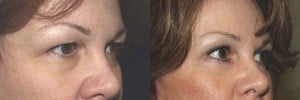Cosmetic Eyelid Surgery: An Overview
As people age, the skin around their eyes tends to accumulate wrinkles and their eyelids may begin to sag or droop. Wrinkles and sagging around the eyes can make a person appear older than they really are and can also diminish their self-confidence. Fortunately, there is a solution. Eyelid surgery, also known as blepharoplasty, is a cosmetic surgery procedure used to tighten sagging eyelids and reduce wrinkles, resulting in a look younger, more well-rested appearance.

During eyelid surgery, a cosmetic, oculoplastic, facial plastic, ophthalmologic, dermatologic, oral/maxillofacial, or plastic surgeon will cut small incisions into the eyelids and reposition the muscles and tissues under the skin. The incisions are either made in the crease of the upper lid, the inside of the lower lid, or both. The surgeon will then remove loose skin and excess fat while repositioning existing tissue to improve drooping and sagginess. Next, she or he will carefully stitch the skin using sutures.
Lasers and radiofrequency can be used to assist in eyelid surgery. However, the avoidance of heat during surgery speeds healing and lessens discomfort. Typically the sutures are ready to come out in three days.
Oftentimes, this procedure is combined with fat grafting to the cheeks, tear trough, and brows to more comprehensively rejuvenate the upper two-thirds of the face. Minimal access browlift or browpexy is commonly performed at the same time.
Swelling and bruising is typically mild to moderate and most patients are “socially” comfortable at seven days. Discomfort is very minimal and the procedure can be performed under local anesthetic.
The eye is considered by many as the most important aesthetic area of the face and, thus, a very satisfying area to rejuvenate for both patient and surgeon.